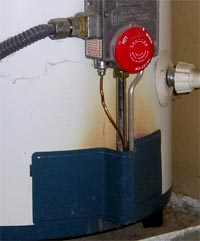During a
power outage caused by the windstorms in December 2006, a gas
generator killed an entire family in Burien Washington. Carbon
monoxide kills nearly 150 Americans a year. This statistic
drove us to further research this topic. There are many
possible sources of carbon monoxide in a home, and most people
have no idea of the hazards they can pose.
We recommend anyone that uses gas, oil or wood
appliances and fireplaces should heed these warnings to
protect themselves and their families from this potentially
fatal hazard. Furnaces, boilers, hot water heaters,
fireplaces, gas ranges, gas grills, charcoal barbeques, cars,
generators and gas powered tools are all common sources of
carbon monoxide.

This
hot water heater has exhaust rollout. Improper flue
design or inadequate air supply can cause combustion
gases to vent into the home. If your heater has these
stains please have it checked out. |
Controlling combustion appliance exhaust
leaks.
When exhaust from appliances leak into homes the results can
be very serious, even deadly. All types of heating systems
with the exception of electric heat have the possibility of
back drafting gases. Hot water heater, fireplaces, clothes
dryers, gasoline powered vehicles and tools all produce toxic
exhaust. Venting of these are crucial for removing hazardous
gases from your home, and if improperly installed or
maintained serious hazards can result.
Dryers, kitchen and bathroom fans, and window
fans all force air out of the house and can be a source of
"back drafting hazards". Care should be taken when
fans are exhausting the house. These can cause a negative air
pressure pulling gases backwards through their flue dumping
combustion gasses in the home. With woodstoves or fireplaces,
smoke being drawn into the living space is obvious. The
evidence from other appliances is not always easy to detect.
This problem has been more evident in today's tighter
constructed homes. Older houses typically had more air leaks
providing a fresh air supply for the fans. Carbon monoxide has
no color or odor and therefore, we recommend carbon monoxide
detectors in all homes.
In addition to carbon monoxide, other
combustion gases can be a hazard. Carbon dioxide, nitrogen
oxides and others are often present. In the case of nitrogen
oxide exposure, there can be damage to lungs, exacerbate colds
and cause resperatory illnesses. High concentrations of carbon
dioxide will displace the vital oxygen supply in the home.
Your best protection is to install carbon monoxide detectors
that are approved by Underwriters Laboratories. Understand how
they work, some are "hard wired" others are battery
powered. As with smoke detectors, all battery powered
detectors must be on a regular maintenance schedule changing
the batteries and tested yearly. Remember, unlike smoke
detectors, when a carbon monoxide detector goes off there is
rarely any other evidence of the hazard. Don't make the deadly
mistake in assuming that the unit is malfunctioning because
there is no odor or smoke.
Carbon monoxide safety
checklist.
-
Professional regular
maintenance is the key. Common problems to check for
include breaches in the heat exchanger, condensation in
flues and proper exhaust drafting at startup.
-
All these appliance
should have their burners checked to assure proper venting
and combustion. A well adjusted burner produces much less
carbon monoxide and provides more efficient heat.
-
In the case of an oil
fired furnace this is likely to pay for itself. Oil
burners require more precise adjustments and if properly
maintained the efficiency will be optimal, saving precious
fuel.
-
Make sure all combustion
appliances have good supply of fresh air. When air supply
is restricted they are much more likely to produce high
levels of carbon monoxide and possibly have back drafting
issues.
-
Modern sealed units draw
fresh combustion air from outside. Consider replacing
older style appliances with those that have their own
dedicated air supply.
-
NEVER run cars, mowers,
generators or other gas powered devices in homes or
garages.
-
NEVER use gas grills or
charcoal barbeques indoors.
-
Install carbon monoxide
detectors - smoke alarms are not the same thing. Test them
and change the batteries yearly. We recommend battery
powered ones since many carbon monoxide deaths occur
during power outages when people are most likely to
attempt to keep homes warm with alternate heat sources.
Home
Inspections of Puget Sound

![]()